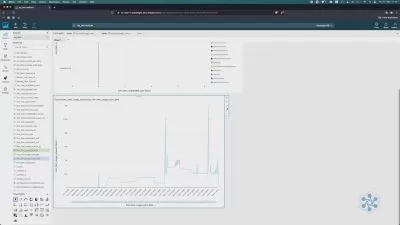Financial Accounting and Cost Accounting
Ankit Kumar Bajaj
10:18:34
Description
Dive deeper into the preparation and interpretation of financial statements, including account concepts and GAAP
What You'll Learn?
- Explain how the balance sheet, income statement, and statement of cash flows are used, what they measure, and why we need three statements.
- Explain what is the balance sheet equation and why the balance sheet equation is the foundational model for accrual accounting/double entry accounting
- Explain how the statement of cash flows and income statement link into the balance sheet
- Locate a real company’s annual report at their website and locate their financial statements within the annual report
- Explain the give and take of a transaction and how to record both sides of the transaction separately with the six stakeholders
- Explain why you can’t measure profit with cash and why you need to use accrual accounting (double-entry accounting), not cash accounting
- Explain the basis for bookkeeping and basic accounting without learning bookkeeping
- Explain how the format of the operating activities section differs from the other two activities (investing and financing)
- Differentiate between income and cash flow
- Define what are assets, liabilities, and equity and how assets, liabilities, and equity relate
- Explain who are the six most important stakeholders of a corporation (employees, customers, government, vendors, lenders, investors)
- Explain which side of the give and take appears on the income statement and on the statement of cash flows
- Illustrate how accrual accounting can both record cash and profits using a spreadsheet
- Explain what each line item of the balance sheet means and distinguish between current and noncurrent assets, liabilities, and shareholders’ equity
- Explain each important line item for the three sections of the statement of cash flows: operating activities, investing activities, and financing activities
- Explains cost accounting systems
- Explains main manufacturing cost elements
- Explains cost from the view point of the relationship with cost centers
- Calculates production cost according to the job cost system
- Calculates product costs according to the process costing
Who is this for?
What You Need to Know?
More details
DescriptionTo familiarize students with the mechanics of preparation of financial statements, understanding corporate financial statements, their analysis and interpretation, role of IFRS in accounting discipline, and the concept of management quality analysis and wealth creation.
Learning Outcomes
· Understand the process of recording and classifying the business transactions and events
· Understand the financial statements, viz., Profit and Loss Account, Balance Sheet, and cash flow statement of a sole  proprietor.
· Understand the role of IFRS/Ind-AS in accounting discipline.
· Understand and Analyze the financial statements from different the perspective of different stakeholders using ratio analysis.
· Understanding of financial distress or bankruptcy prediction and how to analyze management quality means the concept of beyond balance sheet.
The Importance of Financial Statements in Today’s World
The language of business is encapsulated in financial statements. Financial statements provide a scorecard for how a business is doing. Over a series of years, it provides a map of the business’s performance. Managers judge the success of their business with financial statements. Investors make intelligent investing decisions with financial statements. In addition, people in the business world are being held more accountable for their financial statement practices since Enron and WorldCom. They need to know what goes into financial statements.
Learn to Read Financial Statements, Not Prepare Them.
Just as you don’t need to understand how to make a car in order to drive one, you don’t have to understand bookkeeping to read financial statements. I've prepared a course that eliminates the bookkeeping drudgery and concentrates on the end product of accounting, how to read financial statements, not how to prepare them.
Like climbing a spiral staircase, I will teach you how to read three real company’s financial statements (Whole Foods, Sherwin Williams, and Facebook), starting with the simple and progressing to the complex, interspersing the statements with key accounting terms and concepts to help you build expertise.
Who this course is for:
- Business students who want a big picture view of accounting by understanding the end product, financial statements, not how the end product is created through bookkeeping
- Managers who want to read and understand financial statements without learning bookkeeping
- Investors who want to read and understand annual reports
- Non-accounting/finance employees in companies who want to determine how their company is doing without taking an accounting course
- Accounting/finance majors should not take the course
To familiarize students with the mechanics of preparation of financial statements, understanding corporate financial statements, their analysis and interpretation, role of IFRS in accounting discipline, and the concept of management quality analysis and wealth creation.
Learning Outcomes
· Understand the process of recording and classifying the business transactions and events
· Understand the financial statements, viz., Profit and Loss Account, Balance Sheet, and cash flow statement of a sole  proprietor.
· Understand the role of IFRS/Ind-AS in accounting discipline.
· Understand and Analyze the financial statements from different the perspective of different stakeholders using ratio analysis.
· Understanding of financial distress or bankruptcy prediction and how to analyze management quality means the concept of beyond balance sheet.
The Importance of Financial Statements in Today’s World
The language of business is encapsulated in financial statements. Financial statements provide a scorecard for how a business is doing. Over a series of years, it provides a map of the business’s performance. Managers judge the success of their business with financial statements. Investors make intelligent investing decisions with financial statements. In addition, people in the business world are being held more accountable for their financial statement practices since Enron and WorldCom. They need to know what goes into financial statements.
Learn to Read Financial Statements, Not Prepare Them.
Just as you don’t need to understand how to make a car in order to drive one, you don’t have to understand bookkeeping to read financial statements. I've prepared a course that eliminates the bookkeeping drudgery and concentrates on the end product of accounting, how to read financial statements, not how to prepare them.
Like climbing a spiral staircase, I will teach you how to read three real company’s financial statements (Whole Foods, Sherwin Williams, and Facebook), starting with the simple and progressing to the complex, interspersing the statements with key accounting terms and concepts to help you build expertise.
Who this course is for:
- Business students who want a big picture view of accounting by understanding the end product, financial statements, not how the end product is created through bookkeeping
- Managers who want to read and understand financial statements without learning bookkeeping
- Investors who want to read and understand annual reports
- Non-accounting/finance employees in companies who want to determine how their company is doing without taking an accounting course
- Accounting/finance majors should not take the course
User Reviews
Rating
Ankit Kumar Bajaj
Instructor's Courses
Udemy
View courses Udemy- language english
- Training sessions 84
- duration 10:18:34
- Release Date 2024/05/04











